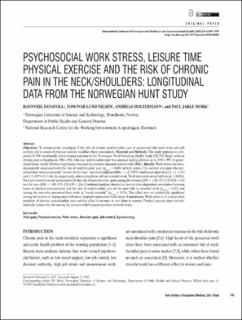| dc.contributor.author | Fanavoll, Rannveig | |
| dc.contributor.author | Nilsen, Tom Ivar Lund | |
| dc.contributor.author | Holtermann, Andreas | |
| dc.contributor.author | Mork, Paul Jarle | |
| dc.date.accessioned | 2020-03-24T14:47:00Z | |
| dc.date.available | 2020-03-24T14:47:00Z | |
| dc.date.created | 2017-01-20T13:37:47Z | |
| dc.date.issued | 2016 | |
| dc.identifier.citation | International Journal of Occupational Medicine and Environmental Health. 2016, 29 (4), 585-595. | en_US |
| dc.identifier.issn | 1232-1087 | |
| dc.identifier.uri | https://hdl.handle.net/11250/2648418 | |
| dc.description.abstract | Objectives: To prospectively investigate if the risk of chronic neck/shoulder pain is associated with work stress and job control, and to assess if physical exercise modifies these associations. Material and Methods: The study population comprised 29 496 vocationally active women and men in the Norwegian Nord-Trøndelag Health Study (HUNT Study) without chronic pain at baseline in 1984–1986. Chronic neck/shoulder pain was assessed during a follow-up in 1995–1997. A generalized linear model (Poisson regression) was used to calculate adjusted relative risks (RRs). Results: Work stress was dosedependently associated with the risk of neck/shoulder pain (ptrend < 0.001 in both sexes). The women and men who perceived their work as stressful “almost all the time” had multi-adjusted RRs = 1.27 (95% confidence interval (CI): 1.1–1.47) and 1.71 (95% CI: 1.46–2), respectively, referencing those with no stressful work. Work stress interacted with sex (p < 0.001). Poor job control was not associated with the risk of neck/shoulder pain among the women (RR = 1.04, 95% CI: 0.92–1.19) nor the men (RR = 1.09, 95% CI: 0.95–1.26). Combined analyses showed an inverse dose-dependent association between hours of physical exercise/week and the risk of neck/shoulder pain in the men with no stressful work (ptrend = 0.05) and among the men who perceived their work as “rarely stressful” (ptrend < 0.02). This effect was not statistically significant among the women or among men with more frequent exposure to work stress. Conclusions: Work stress is an independent predictor of chronic neck/shoulder pain and the effect is stronger in men than in women. Physical exercise does not substantially reduce the risk among the persons with frequent exposure to work stress. | en_US |
| dc.language.iso | eng | en_US |
| dc.publisher | Instytut Medycyny Pracy im. prof J. Nofera | en_US |
| dc.rights | Navngivelse-Ikkekommersiell 4.0 Internasjonal | * |
| dc.rights.uri | http://creativecommons.org/licenses/by-nc/4.0/deed.no | * |
| dc.title | Psychosocial work stress, leisure time physical exercise and the risk of chronic pain in the neck/shoulders: Longitudinal data from the Norwegian HUNT study | en_US |
| dc.type | Peer reviewed | en_US |
| dc.type | Journal article | en_US |
| dc.description.version | publishedVersion | en_US |
| dc.source.pagenumber | 585-595 | en_US |
| dc.source.volume | 29 | en_US |
| dc.source.journal | International Journal of Occupational Medicine and Environmental Health | en_US |
| dc.source.issue | 4 | en_US |
| dc.identifier.doi | 10.13075/ijomeh.1896.00606 | |
| dc.identifier.cristin | 1433839 | |
| dc.description.localcode | This work is available in Open Access model and licensed under a Creative Commons Attribution-NonCommercial 3.0 Poland License | en_US |
| cristin.ispublished | true | |
| cristin.fulltext | original | |
| cristin.qualitycode | 1 | |

